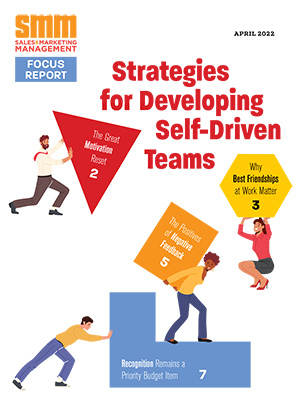Manufacturers’ relationships with independent sales reps cannot be the same as their relationship with factory salespeople. Independent sales organizations are just that: independent.
Independent reps have their own business goals and requirements. There are built-in differences that can lead to tensions, and even an adversarial relationship, unless the independent channel is treated as a business partner.
Just as in marriages, the relationship is usually only as good as the weaknesses of both parties and their ability to communicate. Here are some factory complaints about reps I hear over and over:
“Reps spend time on everybody’s product but mine.”
“Reps are only interested in quick dollars and easy orders.”
“Reps always go for the easy sale and won’t do any prospecting or market development.”
“Reps are not loyal to our company or our products. They sell what’s easiest to sell.”
Most manufacturers I talk to often describe sales coverage for independent reps and distributors as “poor” or “inadequate.” In my experience, few manufacturers achieve the kind of sales and market success they really need with independent sales channels, because the emphasis is only on sales quotas.
Not much effort is spent defining the market segments, assessing the different types of customers, listing all of the required tasks of the job, and finding out whether the rep has the necessary skills to do the job.
What follows is a six-step process for thoroughly and fairly evaluating rep performance and sales coverage:
1. What type of rep? The first question: Do you need a specialist or generalist independent rep? A specialist rep is highly trained and understands the technical aspects of the products, as well as factory salespeople. They can do everything a direct salesperson can do—save for the fact they’re independent and only devote part of their selling time to your product line.
These reps usually represent only a few complimentary product lines so, every call they make has the potential of selling any of their product lines. Specialist reps are needed for job shops and manufacturers of custom and engineered products.
On the other hand, standard independent reps (generalists) are very good salespeople who lack the technical knowledge. They succeed by having many different product lines and calling on many different types of markets and customers. It is up to the manufacturer to select the type of rep that has the best chance of doing a good selling job in the defined markets.
2. Market segments. The process should begin by listing all of the market segments you sell (preferably by SIC code). If market segments are unknown, begin by segmenting your account list into customer groups. Do the reps have the contacts, capabilities, or interest to cover all of these market segments? Second, which market segments are they selling their other product lines?
If you find the reps do not sell to your specified market segments or don’t know enough about a specific market segment to make much headway, you will need to develop a different sales strategy for the territory. One solution is to break territories down into market segments and look for specialized reps who do have contacts, as well as a good sales track record in the specific industry or segment.
3. Customer types. The second step is to profile your the customers by SIC code, size, or type. You may have customers ranging from small food plants to publicly held multinational corporations. If you find the reps can’t (or won’t) call on certain customer types because they don’t have the necessary skills, or the customer doesn’t think they can add value, you may have to change your channel strategy.
Covering very large companies or OEMS with very technical products usually requires unique selling approaches, or else finding a specialized rep who is acceptable. Sometimes the answer is a combination of factory and reps with an appropriate commission.
4. Sales analysis and potential. You need to examine the sales history for the territory over a period of years. Determine what the lowest and highest sales have been in the territory and the commissions paid. Past commission is one indicator of territory potential.
Another question: How do you determine future sales potential for this product in the assigned territory? The factory probably has a projected sales figure they would like to see achieved, and the rep probably has a projected commission figure they need to achieve. Both can probably be combined into a practical sales forecast,, but these figures need to be substantiated.
A simple way to assign a ballpark idea of sales potential is to create profiles of the best customers in each niche. Including SIC code and size (in terms of employees), then buy a prospect list of all prospect companies in the territory.
5. Product line synergy. Another important evaluation tool is to examine the reps’ product lines. The synergy of your products with other product lines carried by the reps is critical because of accounts and sales calls.
If a rep’s line card includes synergistic machines—which can all be sold to the same production line and customer—he has a chance to sell all of his products to the same customer. From the principal’s (manufacturer’s) point of view, it means the rep will make more calls on their behalf in any given year because of product line synergy.
On the other hand, if the rep’s line card carries a wide variety of product lines, which are sold into many different markets, he cannot sell all of his products to the same customer. This means having to make many sales calls on different types of customers.
This in turn means the rep has low product line synergy. He will make fewer calls per year for any given principal compared to the rep in the previous example.
The bottom line for the manufacturer is this: Anyone carrying the low-synergistic product lines will not spend enough time on the customer accounts they need covered. In this case, the manufacturer also needs specialized manufacturer’s reps, because their product lines have evolved to become very engineered and technical.
6. Sales tasks and performance. To fairly evaluate rep performance, it is necessary to break the selling job down to the tasks required. The following performance scale is designed for industrial reps and focuses on the tasks of selling technical or engineered products. Each task should be rated on a scale of 1 to 10 (10 being the most proficient).
1. Focuses in the right market niches.
2. Compatible product lines.
3. Technical background and knowledge.
4. Response to inquiries and account opportunity.
5. Ability to sell into new markets.
6. Computer-based inquiry/sale tracking.
7. Use of telemarketing as support.
8. Ability to sell systems.
9. Constantly asks for more inquiries.
10. Product knowledge on your line.
11. Pre-sale information gathering.
12. Use of direct mail for market probes.
13. Provides customer CAD drawings.
14. Response to product training.
15. Follows up on lost orders.
16. Ability to do proposals/quotations.
17. Sales and quotation reporting.
18. Territory organization and management.
19. Overall communication with factory.
20. Achieves sales coverage and forecast.
If the factory managers score any tasks in the 1 to 3 range, these are “red flag” items that need attention. If there are a lot of red flags, you’d better take a serious look at the relationship. Use this form as an agenda to discuss how improvement can be made on each task.
Mike Collins is the author of “Saving American Manufacturing” and its companion book, the “Growth Planning Handbook for Manufacturers.” To learn more about the author or these titles, visit www.mpcmgt.com.
Evaluating Independent Manufacturing Reps
Get our newsletter and digital focus reports

Stay current on learning and development trends, best practices, research, new products and technologies, case studies and much more.

